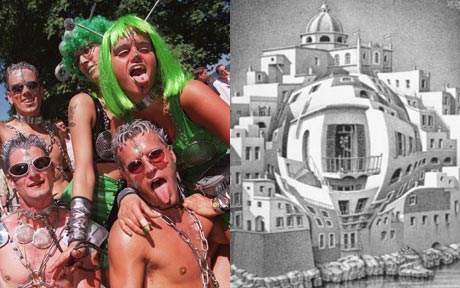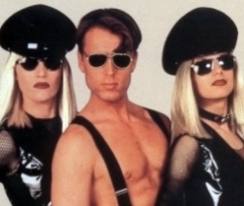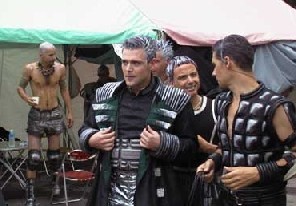Most of us know how Rammstein has been involved and linked to some incredible controversies ranging from promotion of Nazi propaganda, to inspiring mass shootings. While the band is currently “off the radar”, in the past Rammstein has been scrutinized and unjustifiably accused of such actions due to what I believe is the product of our negative views of Germans. As discussed in an early blog post, Rammstein brings authentic German national identity to their lyrics and imagery in a positive light. However, not all reviewers and academics see these indicators as positive. Some even misinterpret their imagery completely as allusions to neo-Nazism when they were not supposed to mean anything at all.
One of the more baffling and desperate attempts to connect the band to Nazism is references to their stage presence. An article by Robert G.H. Burns on German symbolism in rock music uses one of the bands most famous performances to demonstrate the use of the bands neo-classic, neo-Nazi imagery. Burns explains the opening of the performance as such:
“…stage lighting and spotlights were dimmed to highlight a large red curtain, illuminated by flaming torches, which covered the stage area. This scene may be construed as reminiscent of the Nuremburg rallies of the late 1930s that often took place at night with red Nazi banners illuminated in a similar way. As the curtains opened, single spotlights separately illuminated each individual member of the band, who remained completely static.”
Wow. I can’t tell you how many concerts and shows I’ve been to where there was a large red curtain before the act went on. I guess I should have immediately thought of Nuremburg rallies! He then continues to describe this static, mechanical nature through their costuming and physique as a reference of “mechanical-kinetic constructivism that in existed in German theater in the 1920s” (which was left-winged, by the way). The costumes were made out of silver and black material, with some members using white contacts that gave them a more mechanical look. He also mentions the silver makeup used to highlight strong facial features, as well as a “visual emphasis on the muscular physique of the band members, some of who performed bare-chested.” I’m pretty sure Oliver Riedel (the bass player who is the only one shirtless in the beginning), would not be considered a poster-boy for extreme masculine physique, but to each his own I guess. I would like to add a side note that the groups entrance to this seems nothing more than a very cool, exciting, and powerful way to entertain such a large audience. The effect of the members seemingly coming out of thin-air gives the audience a message stating that I interpret as, “We are Rammstein. We are here.” But the kicker that made me laugh written by this author is:
“The emphasis placed on the static and physical forms in Rammstein’s imagery can be compared to the works of sculptors Josep Thorak, Fritz Klimsch and Arno Breker, all of whom were official state artists of the Third Reich.”
That is a serious accusation, and a seriously absurd one. In 1998, Rammstein was considered a more industrial-techno genre band. We all know the 90s was certainly a time for silly, futuristic costumes, especially where German techno is concerned. Take a look at these pictures.
When I think of 90s German raves/techno, I picture these people below.  And these guys…
And these guys…
 And this…
And this…
Oh, and these guys from Dude, Where’s My Car?
 In the late 90s and at this concert, Rammstein looked like this:
In the late 90s and at this concert, Rammstein looked like this:
 Nazis, or nerdy stereotypical German techno-garb? You decide.
Nazis, or nerdy stereotypical German techno-garb? You decide.
Here is also a full video of the concert Burns is referencing. All you need to watch is the first 2 minutes to see what he is describing. You be the judge on whether this screams Nuremburg and the Third Reich:
This is also not the first time the group has suffered criticism for promoting masculinity as National Socialist propaganda. The first album Herzeleid, released in 1995, originally had a cover that had all six members on the front without a shirt on. This received much criticism that they were promoting “poster boys for the Master Race”. For the American release, they were forced to change the cover to show just their faces. The original cover is still unavailable in the US today unless you were to get an import. It is obvious that this claim was due solely to the fact that they are Germans. The 90s had it’s fair share of shirtless men – and you never heard of their covers changed for being too politically provocative.
Original cover:
US cover:
Probably one of the most important Rammstein reviews in America was from a New York Times article that also alluded to the imagined neo-Nazi concept of the band. The author Berlinski wrote that,
“A huge curtain dropped, revealing a row of massive Potemkin amplifiers that flashed with the band’s insignia, something like a swastika.”
Here is the bands insignia:
I just don’t get it. The image is clearly and simply a capital R crossed with a lowercase T representing letters in the band’s name – Rammstein. Why reference something that doesn’t look like a swastika? I guarantee if the band was not German, this comment would not even be thought of. People are searching high and low to promote a not-so-PC band like Rammstein as taboo – something their children shouldn’t listen to, and something to continually give reason to promote bigotry towards Germans. What happens with an article like this is that non-Rammstein fans read this and create an uneducated vision of the band and assume the writers point of view is the correct one. Articles like this, especially in America, gave Rammstein their bad name.
The point of Rammstein is that they do write about uncomfortable topics – such as sex, masochism, and murder. They write about these things to start a commotion and gain popularity – and it worked. They aren’t Germany’s most successful international act without reason. In essence, they did this without ever meaning to promote nationalist propaganda, except possibly once…
One of their biggest controversies was the use of clips from famous director and actress Leni Riefenstahl’s nationalistic propaganda film, Olympia. The film documented the Berlin Olympics in 1936 and was sanctioned by Hitler to create a revival of German nationalism. The film showed powerful and fit athletic bodies (some nude) performing an array of actions. The film was meant to showcase to the world German prowess and pride. Riefenstahl was arrested after WWII, but released on no charges – claiming that she was not aware of what was going on or what she was filming for. Rammstein used parts of this film for a video for Stripped, a Depeche Mode cover (which is in English). Rammstein took out all images of Nazi propaganda, and simply used it because it was beautiful imagery. In 2007, almost 10 years after the video, Lindemann was asked about it in a Playboy Magazine interview and had this response:
Playboy: For your video of “Stripped” you used some material from Leni Riefenstahl’s “Olympia” movie. Would you do such a thing again?
Lindemann: No. Because I am fed up with allegations of being a right wing band. My daughter – my dearest in my life – came to me at that time to ask me: tell me, do you play in a Nazi band? At this point I knew we had overstepped a border. That was too much for me.
It is clear that at one point, Rammstein did try to spark controversy for the hell of it. I just don’t think they expected to see it hit that hard. It is also interesting to play around with the “too soon?” concept. I wouldn’t doubt if Rammstein was trying to use this imagery to see how far the world’s perception has come. It became clear that nobody has forgotten the negative connotations of Olympia, even though it was so long ago. The band almost begs to for an answer as to how long their music, their people, and their country will suffer for something they had no direct involvement in. It is the similar to still blaming white Americans for enslaving blacks and taking Native American land – something absolutely horrible that none of us alive today (at least in younger generations) had anything to do with. Here is the video for Stripped:
One important progression that Rammstein did demonstrate to the world was the ever-so controversial live performance of “Bück dich” or “Bend Over”. In 1998, Rammstein performed a lewd act on stage that consisted of Lindemann taking the keyboardist, Flake Lorenz, to the front of the stage to bend over. Lindemann proceeded to take out a large dildo from his pants that squirted a liquid white substance onto him and then into the audience. This act landed the members one night in jail in Massachusetts. Here is the original 1998 version:
After a 10 year drought, Rammstein finally played the US in December of 2011 at Madison Square Garden. The show was a complete success, which led them to do two more tours in the US after. In 2012, 14 years after the original incident, Rammstein performed the controversial “Bück dich” act again in the United States without any issues. In a way, it is quite liberating to see how far we have come as a nation to be more open to these acts as nothing more than hilarious and satirical – which they were originally meant to be. Rammstein was successfully able to take a “sore” event and bring it out in the open again. Here is one of their 2012 performances of “Bück dich”:
To further emphasize their satirical concepts of sex tourism, Rammstein released yet another controversial video. This time, it was for the 2009s “Pussy”, which was literally an X-rated pornography where the band members were shown having full on sexual encounters with women. As a side note, the members heads were fixed upon actors bodies, so they were not the ones actually committing the act. During the live performances of it, Lindemann mounts a very large, phallic-painted cannon that shoots out white foam into the audience for a few minutes. This extremely comical event further emphasizes their stress on the comedic value of dubious lyric material – such as sex and sex tourism.
Getting back to the lines of having no direct involvement in events, Rammstein was further accused of inspiring the two gunmen in the Columbine High School massacre – who were fans of the band. The group issued a statement:
“The members of Rammstein express their condolences and sympathy to all affected by the recent tragic events in Denver. They wish to make it clear that they have no lyrical content or political beliefs that could have possibly influenced such behavior. Additionally, members of Rammstein have children of their own, in whom they continually strive to instill healthy and non-violent values.”
They were also linked to the hostage crisis in Russia where the hostage-takers listened to Rammstein to keep themselves “fired-up” during the siege. Subsequently, Rammstein was banned from playing a show in Moscow in 2002 out of fear that they would draw skinheads (which is quite ignorant, knowing that Rammstein is completely unaffiliated with skinhead music).
As a backlash towards their nationalist accusations, Rammstein released the song “Links-2-3-4” (“Left-2-3-4”) as a sentiment that they were on the left side. Kruspe points out:
“…my heart beats on the left, two, three, four.’ It’s simple. If you want to put us in a political category, we’re on the left side, and that’s the reason we made the song.” (The Grand Rapids Press, Jul. 22, 2001).
However, as a side note to this, the unaccustomed listener would most likely hear the marching of heavy boots in the beginning and throughout the song and instantly connect it to a militaristic sound. Another snide remark from the New York Times article mentioned above that during the performance of this song, the author thought she heard the crowd shouting “Hi!” in unison – which she had to mention only sounded just different enough from “Heil”. I don’t even know where in the song that could possibly be interpreted…
With large flame effects and some satirical-yet-uncomfortable stage antics, Rammstein packs a serious punch that forces you to pay attention. For some people, it is almost too much attention. By wanting to show the world authenticity, the group has received much unwarranted criticism for being extreme right-winged and neo-Nazis. Unfortunately, it doesn’t look like the world is going to completely forgive Germany soon. Even though steps have been taken to promote positivism, Germans, in essence, are still not allowed to be “German” without negative connotations.





